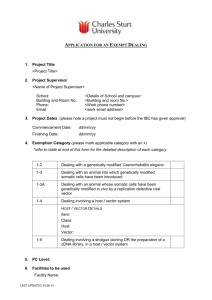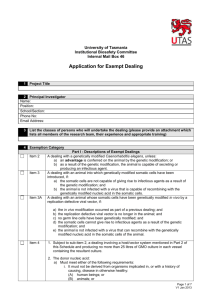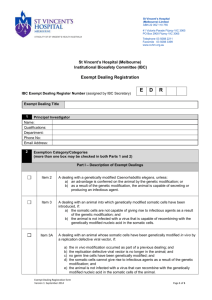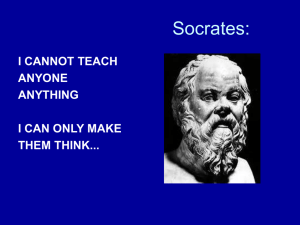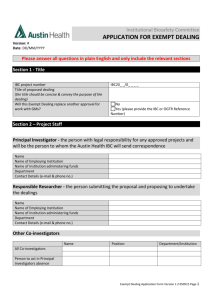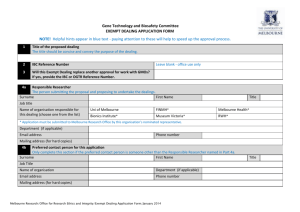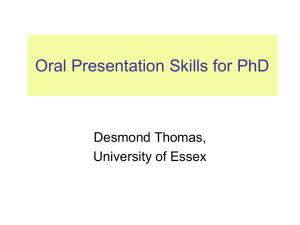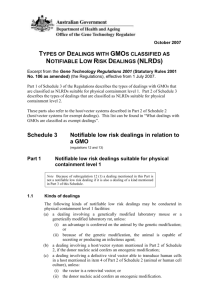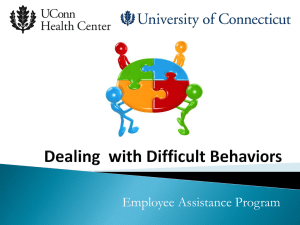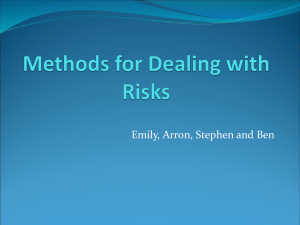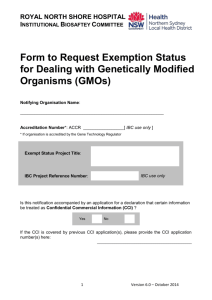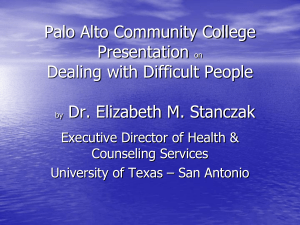Genetic Manipulation
advertisement
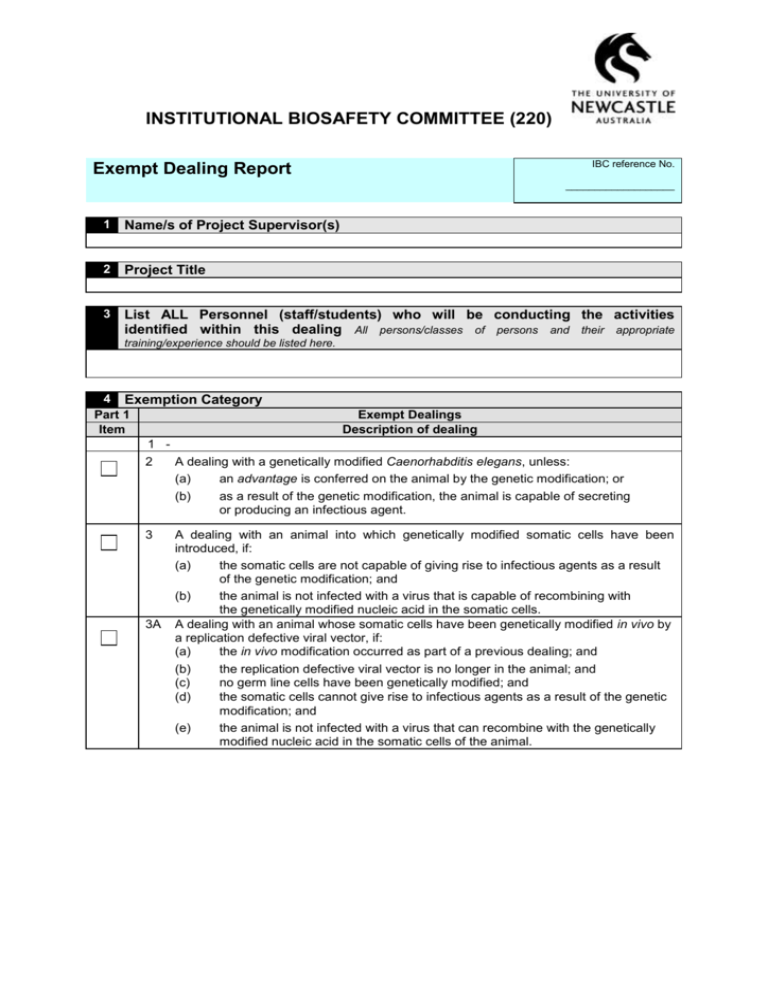
INSTITUTIONAL BIOSAFETY COMMITTEE (220) IBC reference No. Exempt Dealing Report ___________________ 1 Name/s of Project Supervisor(s) 2 Project Title 3 List ALL Personnel (staff/students) who will be conducting the activities identified within this dealing All persons/classes of persons and their appropriate training/experience should be listed here. 4 Exemption Category Part 1 Item 1 - Exempt Dealings Description of dealing 2 A dealing with a genetically modified Caenorhabditis elegans, unless: (a) an advantage is conferred on the animal by the genetic modification; or (b) as a result of the genetic modification, the animal is capable of secreting or producing an infectious agent. 3 A dealing with an animal into which genetically modified somatic cells have been introduced, if: (a) the somatic cells are not capable of giving rise to infectious agents as a result of the genetic modification; and (b) the animal is not infected with a virus that is capable of recombining with the genetically modified nucleic acid in the somatic cells. A dealing with an animal whose somatic cells have been genetically modified in vivo by a replication defective viral vector, if: (a) the in vivo modification occurred as part of a previous dealing; and (b) the replication defective viral vector is no longer in the animal; and (c) no germ line cells have been genetically modified; and (d) the somatic cells cannot give rise to infectious agents as a result of the genetic modification; and (e) the animal is not infected with a virus that can recombine with the genetically modified nucleic acid in the somatic cells of the animal. 3A 4 Exemption Category Part 1 Exempt Dealings Item Description of dealing 4 (1) Subject to subitem (2), a dealing involving a host/vector system mentioned in Part 2 of this Schedule and producing no more than 25 litres of GMO culture in each vessel containing the resultant culture. (2) The donor nucleic acid: (a) must meet either of the following requirements: (i) (ii) it must not be derived from organisms implicated in, or with a history of causing, disease in otherwise healthy: (A) human beings; or (B) animals; or (C) plants; or (D) fungi; it must be characterised and the information derived from its characterisation show that it is unlikely to increase the capacity of the host or vector to cause harm; Example Donor nucleic acid would not comply with subparagraph (ii) if its characterisation shows that, in relation to the capacity of the host or vector to cause harm, it: (a) provides an advantage; or (b) adds a potential host species or mode of transmission; or (c) increases its virulence, pathogenicity or transmissibility; and (b) (c) must not code for a toxin with an LD50 of less than 100 g/kg; and must not code for a toxin with an LD50 of 100 g/kg or more, if the intention is to express the toxin at high levels; and (d) must not be uncharacterised nucleic acid from a toxin-producing organism; and (e) must not include a viral sequence, unless the donor nucleic acid: (i) is missing at least 1 gene essential for viral multiplication that: (A) (ii) 5 is not available in the cell into which the nucleic acid is introduced; and (B) will not become available during the dealing; and cannot restore replication competence to the vector. A dealing involving shot-gun cloning, or the preparation of a cDNA library, in a host/vector system mentioned in item 1 of Part 2 of this Schedule, if the donor nucleic acid is not derived from either: (a) (b) a pathogen; or a toxin-producing organism. GT Regulations Amendment 1 September 2011 Page 2 4 Exemption Category Part 2 Host/vector systems for exempt dealings Item Class Host Vector (delete those not applicable) (delete those not applicable) 1. Non-conjugative plasmids 1 Bacteria Escherichia coli K12, E. coli B, E. coli C or E. coli Nissle 1917 — any derivative that does not contain: (a) generalised transducing phages; or (b) genes able to complement the conjugation defect in a non-conjugative plasmid Bacillus — specified species — asporogenic strains with a reversion frequency of less than 10–7: 2. Bacteriophage (a) lambda (b) lambdoid (c) Fd or F1 (eg M13) 3. None (non-vector systems 1. Non-conjugative plasmids 2. Plasmids and phages whose host range does not include B. cereus, (a) B. amyloliquefaciens B.anthracis or any other pathogenic (b) B. licheniformis strain of Bacillus (c) B. pumilus (d) B. subtilise (e) B. thuringiensis Pseudomonas putida — strain KT 2440 3. None (non-vector systems) 1. Non-conjugative plasmids including certified plasmids: pKT 262, pKT 263, pKT 264 2. None (non-vector systems) Streptomyces — specified species: 1. Non-conjugative plasmids (a) S. aureofaciens 2. Certified plasmids: SCP2, SLP1, SLP2, (b) S. coelicolor (c) S. cyaneus 3. Actinophage phi C31 and derivatives (d) S. griseus 4. None (non-vector systems) (e) S. lividans (f) S. parvulus (g) S. rimosus (h) S. venezuelae Agrobacterium radiobacter Agrobacterium rhizogenes — disarmed strains Agrobacterium tumefaciens — PIJ101 and derivatives 1. Non-tumorigenic disarmed Ti plasmid vectors, or Ri plasmid vectors 2. None (non-vector systems) disarmed strains Lactobacillus Lactococcus lactis 1. Non-conjugative plasmids 2. None (non-vector systems Oenococcus oeni syn. Leuconostoc oeni Pediococcus Photobacterium angustum Pseudoalteromonas tunicata Rhizobium (including the genus Allorhizobium) Sphingopyxis alaskensis syn. Sphingomonas alaskensis Streptococcus thermophilus GT Regulations Amendment 1 September 2011 Page 3 4 Exemption Category Part 2 Host/vector systems for exempt dealings Item Class Host Vector (delete those not applicable (delete those not applicable) 1 Bacteria Synechococcus — specified strains: (a) PCC 7002 (b) PCC 7942 (c) WH 8102 Synechocystis species — strain PCC 6803 Vibrio cholerae CVD103-HgR 2 Fungi Kluyveromyces lactis 1. All vectors Neurospora crassa — laboratory 2. None (non-vector systems) strains Pichia pastoris Saccharomyces cerevisiae Schizosaccharomyces pombe Trichoderma reesei Yarrowia lipolytica 3 Slime moulds Dictyostelium species 1. Dictyostelium shuttle vectors, including those based on the endogenous plasmids Ddp1 and Ddp2 2. None (non-vector systems) 4 Tissue culture Any of the following if they cannot spontaneously generate a whole animal: (a) animal or human cell 1. Non-conjugative plasmids 2. Non-viral vectors, or replication defective viral vectors unable to transduce human cells cultures (including packaging cell lines); 3. Baculovirus (Autographa californica nuclear polyhedrosis virus), polyhedrin (b) isolated cells, isolated minus tissues or isolated organs, whether animal or human; (c) 4. None (non-vector systems) early non-human mammalian embryos cultured in vitro Either of the following if they are not intended, and are not likely without human intervention, to vegetatively propagate, flower or regenerate into a whole plant: (a) plant cell cultures; (b) isolated plant tissues or 1.Non-tumorigenic disarmed Ti plasmid vectors, or Ri plasmid vectors, in Agrobacterium tumefaciens, Agrobacterium radiobacter or Agrobacterium rhizogenes 2.Non-pathogenic viral vectors organs GT Regulations Amendment 1 September 2011 3.None (non-vector systems) Page 4 5 DESCRIPTION OF THE DEALING TO BE UNDERTAKEN NOTE: It is expected that the description of the proposed project would be written using clear language and would include the following details: common and scientific names of the parent organism(s) of GMO(s) identity and source of donor nucleic acid, including common and scientific names of donor organisms, if relevant genetic modification(s), (target genes) method of genetic modification and expected phenotype/trait/outcomes a list of the dealings proposed and assessed (this may be all dealings listed in the definition of ‘deal with’ in Section 10 of the Act unless there is a specific reason for excluding one or more of these dealings) intended use/purpose of the GMOs (eg inoculation into a laboratory animal, cultured in vitro etc). This description should provide sufficient detail for researchers, organisations, IBCs and the OGTR to understand what is specifically authorised. In preparing a proposal (proponent) or describing the dealings to be authorised (IBC), careful consideration should be given to ensuring that it will include all the activities intended to be undertaken. It should not be so narrow as to preclude foreseeable and intended work (which would then need a separate NLRD) nor so broad or general as to lead to confusion about what dealings with the GMOs have actually been proposed and assessed (ie what is authorised). Scientific name of parent/host organism (delete those classes which don’t apply) Algae Animal Bacteria Fungi Plant Protozoa Virus Vector(s) & Method of Transfer Identity & Function of Nucleic Acid & Organism of Origin Modified trait(s) and gene(s) responsible (delete those that do not apply) and provide details Class of modified trait Virus resistance Fungal resistance Bacterial resistance Disease resistance Pest resistance Herbicide tolerance Antibiotic resistance Pesticide resistance Abiotic stress resistance Altered agronomic characteristics Altered horticultural characteristics Altered nutritional characteristics Altered physical product characteristics Altered physiological characteristics Altered pharmaceutical characteristics Attenuation Antigen expression Protein expression Growth factor expression Altered biosensor characteristics Altered bioremediation characteristics Altered biocontrol characteristics Reporter/marker gene expression Immuno-modulatory protein expression Other GT Regulations Amendment 1 September 2011 Details Page 5 6 List all Facilities to be used Note: Generally exempt dealings can be conducted in PC1 facilities, but in line with AS/NZS 2243.3, if human or animal tissues or risk group 2 micro-organisms are involved, the dealing must be conducted in a PC2 facility. Uncertified OGTR certified PC1 OGTR certified PC2 OGTR certified PC3 Building Name/s, Room Number/s and Certification Number/s: 75 Will the dealing involve the import of GMO’s into Australia? No (go to 8) Yes Source OrganisationSource CountryAQIS Import Permit Number8 Expected Commencement date 9 Expected Completion date 10 IBC Assessment The IBC has evaluated this dealing in accordance with Schedule 2 of the Gene Technology Regulations 2001 and based on the information provided with this application the IBC; confirms that the applicant has correctly classified this dealing as an Exempt dealing or has identified that this dealing has not been correctly classified and requests the applicant complete a PC1 NLRD Dealing Application Form or PC2 NLRD Dealing Application Form or PC3 NLRD Dealing Application Form or DNIR Dealing Application Form Assessment Date Expedited Approval Date Notification of Interim Approval Date Noted at IBC Meeting Date GT Regulations Amendment 1 September 2011 Page 6
